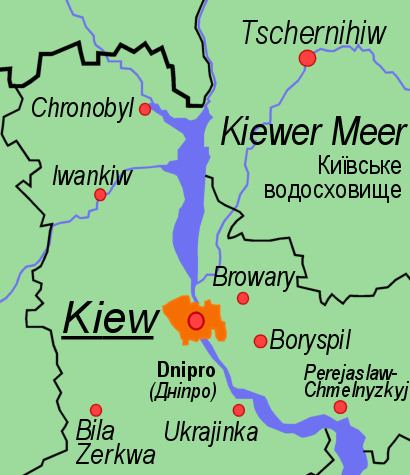 | ||
The water reservoirs of the Dnieper River in Ukraine pose a significant threat of a large-scale human-made disaster if their dams fail. Such a threat is typical for reservoir dams; however, the Dnieper reservoirs are especially dangerous because of the geographical conditions, as well as the consequences of the Chernobyl disaster and other nuclear-related environmental threats in the region.
Contents
The flooding risk
Like other reservoirs, Dnieper reservoirs pose a potential threat of causing major flooding if their dams fail. Such damage may be inflicted by a powerful natural disaster (e.g., an earthquake), a human-made disaster, or a deliberate attack by terrorists or enemy forces at war.
The Dnieper reservoirs contain an additional major threat—after the Chernobyl Nuclear Disaster in 1986, radionuclides washed away by rains badly contaminated the bottom silt of the Kiev Reservoir and presumably the others. During the years following the disaster, there were suggestions to drain the Kiev Reservoir because it was too shallow. It appeared that, if done, this could have created the threat of the tremendous amounts of radioactive dust travelling by wind, lethally affecting Europe.
The dams are supposed to be strong enough to survive natural and terrorist threats. Both their construction schemes and government efforts work towards this goal. For instance, some engineers guarantee that every Dnieper dam will survive an earthquake (to its typical regional extent), meteorite or aircraft falling. There are also countermeasures against overflooding and malfunction of dams. Authorities pay significant attention to safeguarding the dams and bridges by special units of the Ministry of Internal Affairs and other security agencies.
A failure of the Kiev Reservoir would cause a flooding of the low-lying areas of Kiev, mainly densely populated residential neighborhoods. The aftermath of a possible complex flooding also include the spread of radioactive material from the Chernobyl disaster contained in the reservoirs, the widespread contamination by industrial and urban wastes and creation of swamps on bottoms of emptied reservoirs.
In 2001–03 the Security Service of Ukraine organized exercises on the Kiev Hydroelectric station, simulating a possible terrorist attack. The results of the exercises were considered satisfactory.
Government position and recent concerns
New concerns arose in 2005 after a fake terrorist threat case. A police officer, dissatisfied with his commanders, anonymously called an emergency line stating that he had planted a bomb in a cargo train crossing the Kiev Reservoir's dam. An immediate check proved the threat to be fake and the alerter was arrested. But the incident caused another wave of public concern.
In 2012, the former Kiev Hydroelectric Power Plant manager and veteran stated that its dam is guaranteed capable to withstand any physical threat except large space object impact or deliberate military attack of significant scale. However, an emergency plan exists to safely minimize consequences of a space impact if there would be an early warning on it.
